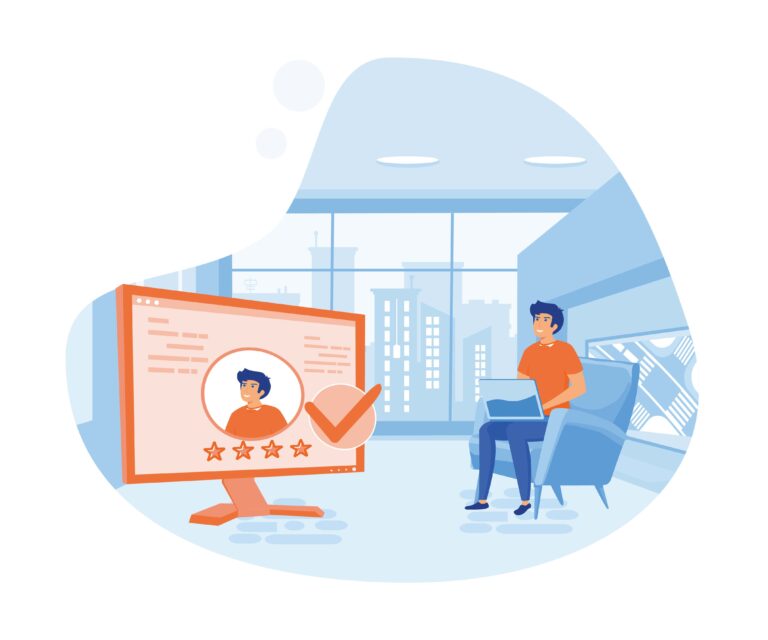Google Ads can often be intimidating for therapists. It’s not what you specialize in – you’re a therapist not a marketer.
However, too often therapists focus only on their patients, and don’t spend nearly enough time growing and expanding their business.
Even though you’re helping patients, they’re still your customers!
In 2025, it seems therapists have two choices.
The first is where you join a giant psychology practice where patients are assigned to you, and you take only a fraction of the profits from your hard work.
The second is where you start your own practice and get your own clients, keeping 100% of the profits from your hard work!
Obviously this second path seems to be the better choice, but finding new patients can be a pain in the butt.
The easiest way to book more therapy clients is through Google Ads.
Step 1: Understanding Google Ads at a Glance
Google Ads is simply a platform that pushes your website to the top of the Google search results.
It’s a “pay-per-click” system meaning the more you pay per click, the higher your website shows up in the search results!
Here’s an example from Evergreen Wellness & Therapy, of what a successful therapist Google Ads advertisement looks like:
When someone clicks on your advertisement, it brings them to your website.
In the therapist market, each click can cost between $0.50 – $15.00 depending on the competition.
You can of course set a limit on how much you want to spend per day, and google will not exceed that.
The more you spend, the more traffic comes to your website!
Is Google Ads Absolutely Necessary?
Google Ads is the short term solution to finding immediate clients for your private practice. The long term solution is SEO, which you can read more about here
Through Google Ads, you’ll see immediate results if done correctly.
The problem is not everyone knows how to run Google Ads correctly, or efficiently.
Should You Hire a Google Ads For Therapists Expert?
Google Ads is a complicated system. It takes time, effort, vulnerability, and emotional energy to put your business at the front of the internet and hope people say yes.
It can often be a waste of your valuable marketing dollars if you don’t know what you’re doing.
It’s so easy to have your ads show up on the wrong screens such as people searching for:
- Massage therapy
- Physical therapists
- Free therapy services
Other common mistakes are setting the bids too high or too low on a keyword, and wasting the day’s budget on the wrong phrase.
Some therapists have the time to learn this all and avoid these mistakes, others do not.
Normally Google Ads costs $500/month, but… with this plan, you can just pay for the leads you get instead
Find Out How We Can Help Grow Your Business
Let’s discuss your marketing needs, and we’ll help you put together a digital marketing strategy that will generate more leads and save you time.
Before we begin our Google Ads for therapists breakdown, you’ll need two things:
- A working Gmail account
- A nice aesthetic looking therapy website
- A monthly marketing budget between $150 – $900
Step 2: Keyword Strategy & Google Ads for Therapists Plan
First let’s define what a keyword is.
A keyword is the word/phrase a Google user types into google. Some nice and juicy therapist keyword examples are:
- cbt therapist
- depression therapist
- counselor near me
- anxiety treatment
- online therapist
When planning a therapist Google Ads strategy, you just have to consider what people are looking for when they want a therapist.
It’s honestly just easy enough to sit and think about what you would Google if you wanted a specific therapy service that you offer.
Developing a keyword plan is crucial because it tells you if your ideas you thought of will work or not. The best tool for this is Google Keyword Planner.
Here you can see a few examples of what a Portland, Oregon therapist would like to see.
Not only can we tell what keywords people are searching for (and more importantly which keywords they’re not), but we’re also getting suggestions for keywords to add to our plan.
It also lets us know the high and low ranges of the cost per click (CPC).
From here we can develop a plan and strategy for our Google Ads Campaign.
Step 3: Create Landing Pages
While I’m sure your website is gorgeous, we do not want people to be going to the home page from these ads.
Why? Because someone searching for CBT therapy, or couple’s therapy, or some other specific therapy services wants to see those services offered right in front of them.
Minimize friction by having the ads traffic go right to the webpage where they can book you for that service!
Simple enough right? We call these “landing pages.” You have to create landing pages for each of the services you want to advertise for.
The landing page should be designed to edge the potential client toward a call to action (CTA), and follow the sales funnel we’ve provided below:
Learn more about custom therapy website design, and other therapy websites here
Call-to-action
Arguably the most important part of a landing page is the Call-to-action.
Not only is it your key to getting these clients to work with you, but it is also how you track your progress and ROI on these ads.
Here are a few examples of solid CTAs from The Center For Compassion Focused Therapy and MindWell NYC
Booking a consultation is the quickest way to securing a new therapy client.
In our professional experience, therapists retain about 1 of every 2 consultations. All we gotta do is get them to click that big friendly button!
Step 4: Creating a Google Ads for Therapists Campaign
It’s free to create a Google Ads account. Once you do, we want to focus on creating our first campaign.
I. Campaign Goals
You’re one and only goal is to get someone to your website. This means traffic is our goal and should be selected as such:
II. Search Network Campaigns vs. Display Network Campaigns
After you’ve created a campaign, the first parameters to set up about the kind of campaign you want to run: Search and/or Display.
Simply put, we recommended only using Search network campaigns (which show your ads on Google search results), instead of Display network campaigns (which show your ads along side Youtube videos, product blogs, online shopping carts, etc).
Display is more for e-commerce, I don’t know about you – but I don’t know anyone who is going to click on a therapy ad while they’re checking out of their Amazon shopping cart.
We want to focus on people who are actively searching for your services.
III. Locations & Budgets
When creating a campaign, you have to ask yourself two crucial questions:
- Where?
- How much?
Each campaign is defined by the location parameters of where you want your ads to show up, and exactly how much you want to be spending on the campaign per day.
This location breakdown usually refers to a local campaign for clients within your city, and a greater state-wide campaign for online therapy services.
The budget breakdown refers to how much your total spend on keywords is each day.
If you have it at $20/day – you can have ten $2 clicks bring you potentially a few consultations!
IV. Keyword Bidding
Think of each keyword as an item up at an auction. Each of your competitors are bidding for that traffic, and Google awards to traffic to the highest bidder.
You can manually decide how much you want to pay per click, or you can select one of the pre-designed bidding strategies Google has to offer, allowing you to set a maximum bid per keyword.
By capping your CPC, you can ensure that you’re spreading the love around to a whole host of keywords – and not blowing your whole budget on one or two clicks that cost $15 each.
Additionally in campaigns you can create Google Ad Extensions which help convert some of the traffic from Google’s search results.
Here’s an additional resource from Google on creating a new advertising campaign
Step 5: Generating Ad Groups
An Ad Group is a collection of keywords in a campaign. See a few examples here:
Within each Ad Group are a series of keywords associated with it, and the actual ads themselves!
A great graphic from Word Stream shows the hierarchy below:
Find Out How We Can Help Grow Your Business
Let’s discuss your marketing needs, and we’ll help you put together a digital marketing strategy that will generate more leads and save you time.
- SKAGs (Single Keyword Ad Groups)
The easiest and most effective way to convert relevant traffic from search results is to “SKAG” your Ads.
“SKAG”ing is a technique used to ensure each Ad Group has 1 keyword it’s focusing on, and therefore one landing page as a result.
The following is an example of what a “Depression Therapists” SKAG would look like:
Each one of these keywords are going to be shown the same ads – so we design the ads to be only for depression therapy and its corresponding CTA.
Here’s an example from MindWell NYC
This advertisement is focused on converting depression related traffic, to a depression related landing pages, to convert that traffic into meetings!
You’re seeing the whole picture now
Step 6: Writing the Therapy Ads Themselves
Writing the ads is the most subjective part of the process. As long as the SKAG keyword is included in the ad, and you have a call to action to follow it, you should see some success
Ideally you’d create 2 identical ads for every SKAG with one small difference – that way you can tell what’s working and what isn’t. We call this A-B testing.
For tips on actually writing your therapy ads, check out this great resource from Word Stream
I have to mention that you can always hire professionals to manage your Google Ads for therapists account. It all depends on the math – so let’s break it down.
Step 7: Doing The Math
As is the case with any marketing endeavor, you want to make sure that you’re making the money back that you’re spending.
- Understanding Lifetime Client/Patient Values
How much does one client make you? Do the research yourself by asking yourself
- How much do I earn from an average session with a client?
- How many total sessions does each client have during the duration of their time working with me?
Multiply those numbers together and you get your lifetime value of a client. In our experience, therapists we market for net an average $175 per session with each client.
Depending on the therapist, each client stays for an average total of roughly 20 sessions.
The range then for the lifetime value of our therapists clients is $3,500 per client!
- Cost Per Acquisition (CPA)
This is the most important part of understanding your ads budgets. If you’re going to spend $50,000 on every client, the math just doesn’t work in your favor there!
Now if your CPA is $50/client – we can start to see some real improvements to your bottom line.
Understand how much you’re spending on your Google Ads, and divide that by the number of clients you’re getting.
If your total costs spent last month was $500, and that got you 10 clients, you’d have a CPA of $50
- Total Costs & Return On Investment (ROI)
Finding a balance of total costs and ROI can be the most challenging part of your marketing endeavor. Let me break it down for you:
ROI = Lifetime Value ➗ CPA
In this example, our Lifetime Value is $3,500 (on the low end) and our CPA is $50.
You’d have a 70X ROI on this marketing campaign.
For most of the therapists we market for, their typical ROI ranges from 10X – 90X. If you’re interested in learning more about our Therapy Marketing Packages you can check it out here!
We hope you’ve learned a ton about Google Ads for therapists, and if you want more information, book a free marketing consultation below!
More Resources
Here are a few more blogs related to therapy marketing. Check them out and let us know your thoughts below!

















